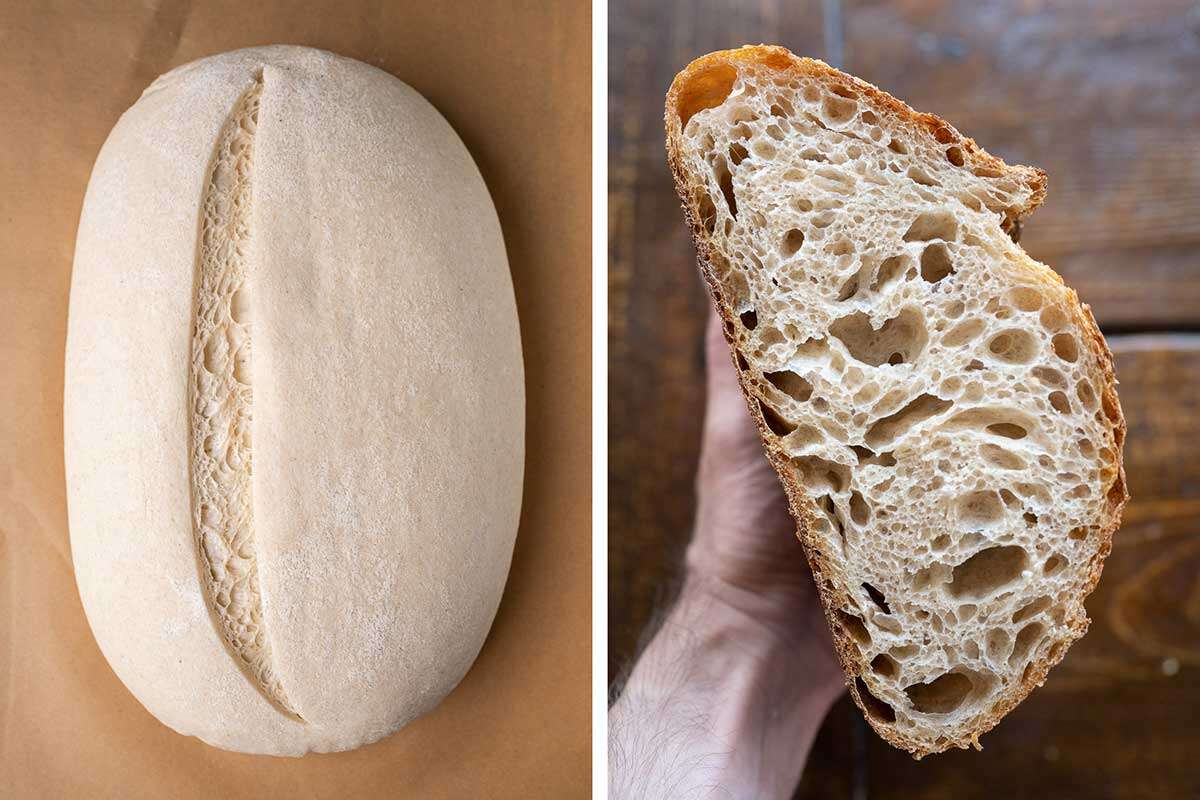Wet doughs have become the drag race of baking. Two bakers, separate hot rods, revving at the start line like, “What’s YOUR hydration?” And, “Oh, yeah?! I go much higher than that!”
There’s no denying that Instagram and social media stoke the appetite for horsepower, high hydration, open crumbs, sailboat “ears,” and complicated shaping — all trademarks of highly hydrated doughs. It’s also clear that many bakers have their foot on the gas, speeding towardthis challenge. But is there a point to it? Are we on the right path?
When it comes to bread, is wetterreally better?
What exactly is "high-hydration"bread?
High-hydrationbread refers toloaveswitha high ratio of water to flour, by weight.In baker’s percentages, we’retalking aboutdoughs that are often in excess of 80%hydration.In some cases, hydration may actually exceed 100% due to the thirsty needs of high protein or whole-grain flours (such asourbread flourorwhole wheat).In those situations, the recipehasmorewater than flour.
High ratios of water, when combined with active fermentation and good gluten development (through time, mixing, and folds), have the potential to significantly open the crumb (or the “alveolar structure”) of loaves. Strong, wet doughs spring well in the oven, forming nice “ears” and, if given time in cold fermentation, a blistered crust. But for many, the most coveted feature of high-hydration loaves is their dramatically open crumb or alveolar structure.In other words, it’s all about the holes.

Chasing the hole-y grail
You’ve likely seen some of these loaves on Instagram, cut open to reveal a wildly open crumb. Bakers like Kristen Dennis, Addie, and Claudioshare photos and tutorials guiding bakers to lacy, high-rising beauties, and their work is undeniably gorgeous.
Thegenesis of this approach is hard totrack, but it isn’t new.My favoriteimageof a baker is anantiqueblack and white photo, shot in a dark French basem*nt. Pooling at the edge of his shaping area, glistening with moisture,slackdoughs waitfor their turn to become slender loaves. The picture is almost 100 years old. Clearlythis ismore than a trend.
Today, bakerieslikePrager Brothersin Carlsbad, CaliforniaandNight Movesin Biddeford, Maine would likely classify much of what they produce as“high hydration.”(I made a video of Night Moves’anadamabread—you can see for yourself how sticky it is.)And they’re not alone. Across thecountry, bakers are producing long-fermented loaves with open structure and burnished crusts, often marked as a “Country Loaf,” with each town adding their own twist to the style.

What are these doughs like to workwith?
Ifyour breadcomfort zone revolves aroundsturdypan loaves,breads withadd-ins,andenriched breads, you may find higher hydration doughs like the anadama from Night Moves difficult to deal with. Sometimes sticky, these doughs benefit from a delicate touch and may require new techniques: like folding rather than kneading and loose shaping. And they take time to make — bad news if you’re out of bread. With multiple hours between the preferment, extended bulk fermentation, and cool overnight rise, patience is an unlisted ingredient.
But for me, they have their own rewards.On my list ofminormiracles is the transformation ofwheatfrom glass-hard grainto powder to a smooth, cohesivemass…I'mspeechless every time. But wet doughsresistthismiracle. Theylackstructure,theystickto my hands,they talk to me like a teenager.
And that’s OK. I’m patient. I step away, I remind myself that the environment is good, my flour is strong, my culture is healthy — the dough will come around. And when I return to check in over the course of a few hours, I sense the change. The mood in the bowl gets cooperative, bonds form, gluten strengthens, knitting itself without my hovering. Faith is restored and the next thing Iknow, I'm shaping, chilling, and baking, and a well-formed kid is on their way to college.

So, is wetter better when it comes to bread?
Maybe.Sometimes.Not always.
Great bread ismadewhenhydration matches the needs of a loafor doughtype. Some are happy with less, some have a sweet spot in the middle, and others need to push the limits. Let’s look more closely.
A stiff, lower hydration dough has great applications in baking. From loaves thatlook better withdefinition (as with braidedchallah), tobagelsorpretzels, which have a more closed crumb structure and toothy chew, too much water can ruin the day.In these loaves,wetter isn’t better.
In the Goldilocks zone between stiff and slack, amedium-hydration doughsupports ahigh-rising loafthathandles nicelyand contains enough water to keep the loaf moist for days (if it lasts that long). The crumb with these doughs isn’t tight, but it isn’t so open that sandwich condiments end up on your shoe. Here, just keep it in the middle — supple and pliable. To these breads I say, come as you are: like date night in sweatpants on the couch, don't go changing.

Andwith high-hydration doughslikeciabattaor pan de cristal,a wet, soft dough with ample strengthis a must.Too little water will leave them dense and, while still delicious, they won’t have the thincrust and lacy interior that's the hallmarkof the style.Yes, they take time — there is alearning curve, but with practice, your rewards will make it to the table.Yes, wetter is better!
Where can you start?
When folks ask abouta starting point fora slack but manageablesourdoughrecipe, I often recommendourPain de Campagne.It’s the daily bread at my house and,while at 80% hydrationitisn’t assoftas some that you’ll see,you’ll get a taste of how these doughs behavewithout jumping intothedeep end.You mayalsofindthisassociatedblog about Pain de Campagnehelpful.And, if youprefer to watch and learn (I recommend both!),here's a video showing how to make this bread recipe.
Cover photo by Mark Weinberg.